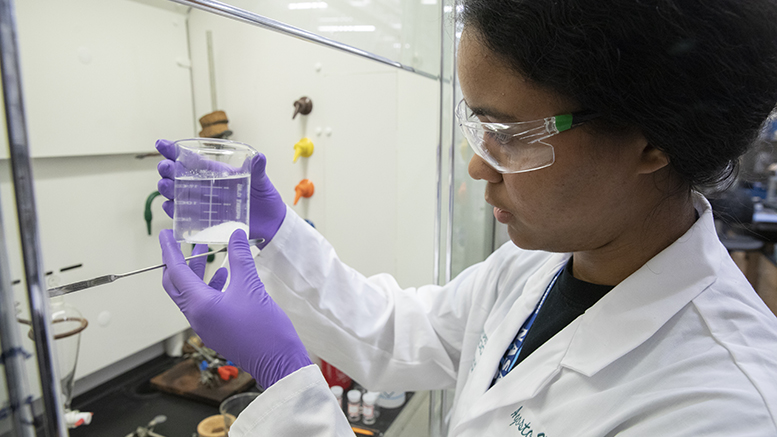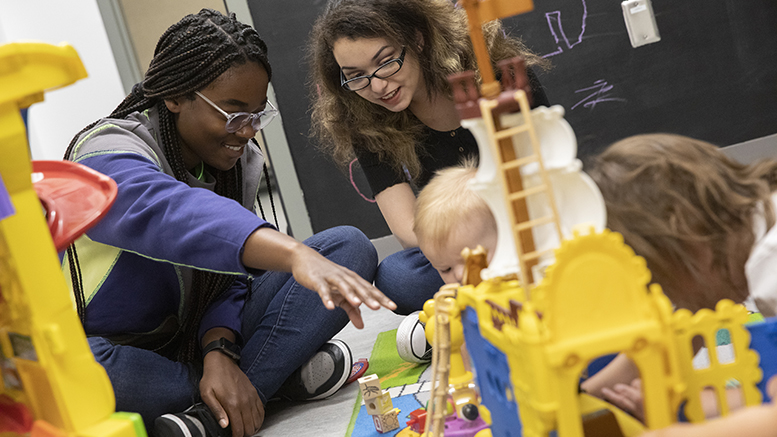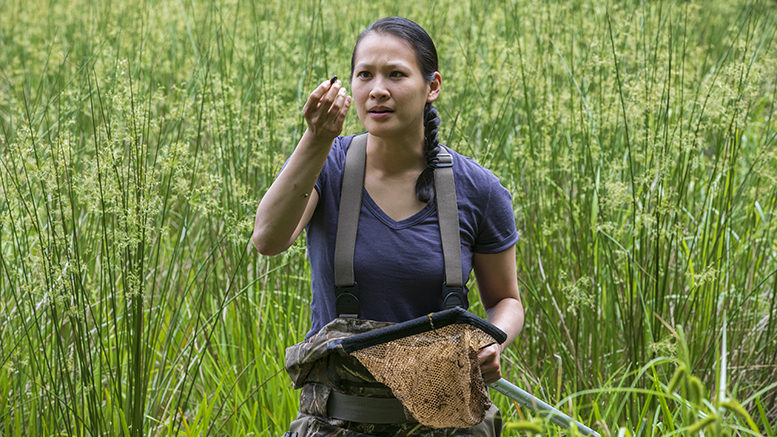Sharlita Hayden spent part of her summer researching the role of biofilms in eczema — virtually.
The coronavirus pandemic didn’t keep the recent Monroe Community College graduate from participating in the Bridges to the Baccalaureate program, which offers talented community college students from underrepresented groups the opportunity to conduct research with Binghamton University faculty in biology, chemistry and psychology.
While unable to visit the lab in person, Hayden connected with her faculty mentor, associate professor of biology Claudia N.H. Marques, through frequent Zoom sessions and worked on analyzing data. She recently applied to the New York university, where she hopes to major in biological sciences and pursue a career in research, with a particular interest in genetic therapies.
Editor’s note: This article is reprinted with permission from the University of Binghamton, SUNY and includes minor style edits.
“I like discovering information that leads me to new questions, and then seeing where that leads. I’ve been able to see what a collaborative force research is,” she explained. “It gives me an opportunity to contribute to the science field.”
That’s the ultimate goal for the program, funded by a grant from the National Institute of General Medical Sciences: to encourage students such as Hayden to complete a four-year degree in biomedical sciences, and show them the possibilities of a career in research. The broader goal is to draw a more diverse array of professionals in the field at all levels, from medical doctors and researchers to laboratory technicians.
“It’s important to see diverse people at every stage of the pipeline,” explained psychology Professor Lisa Savage, co-director of the program with psychology professor Patricia Di Lorenzo. She knows that firsthand: A Native American, Savage participated in a similar program during her undergraduate years at the University of Minnesota at Duluth.
New Bridges student Justin Mariani is aiming for medical school and a future as a surgeon. Like Hayden, the Onondaga Community College student worked in Marques’ biofilm lab this summer, and will transfer to Binghamton this fall.
“It’s definitely not for people who aren’t determined. It’s work, but it’s a lot of fun as well,” he said of Bridges. “It’s so rewarding at the end and it looks great on your résumé.”
Diversifying the sciences
Bridges draws students from Onondaga, Monroe and Westchester community colleges who are African-American, Hispanic American, Native American or natives of the U.S. Pacific Islands, as well as individuals with disabilities or from a disadvantaged background. Participating students are guaranteed admission to Binghamton if they maintain at least a 2.7 grade point average. The majority of students have much higher GPAs.
Over the past two decades, the program has mentored approximately 340 students, usually between 18 and 20 a year. About 80 percent go on to earn a four-year degree, something achieved by only 20 percent of community college students as a whole. Out of those 80 percent who transfer, about 20 percent go on to earn a master’s degree and 5 percent receive their PhD. Others go on to medical school or other health-related careers.

Initially, many students don’t know of the array of career possibilities associated with biomedical sciences, said Di Lorenzo, who has been involved in the program since its start.
“Our summer research experience is in a state-of-the-art lab, and it changes their lives and perspectives. The research that they’re doing in these labs isn’t done unless it’s publishable,” she said.
Community college students can find themselves intimidated by the “big, broad college experience” at a major university, Hayden said. The Bridges to Baccalaureate program is just what the name implies: a way to bridge the gap between two- and four-year schools, she said.
Each participating community college has a Bridges team that recruits students and supports them at the two-year school. That support continues once they transfer to Binghamton, with a combination of mentoring, tutoring and financial assistance.
Bridges transfer students can also take advantage of other opportunities at Binghamton, including the McNair Scholars, the Collegiate Science and Technology Entry Program, the Louis Stokes Alliance for Minority Participation and Student Support Services.
On campus, students take a weekly Culture of Science course, which covers topics ranging from scientific ethics to résumé-writing and managing finances. Bridges scholars and alumni also take part in biweekly lunches that build community in the program, and have opportunities to present their research.
Additionally, the program maintains a space for Bridges students with computers and printers for their use, along with textbooks from popular biosciences courses that they can use or borrow.

Roberto Fernandez successfully transitioned from Onondaga Community College to Binghamton, where the psychology major is a rising senior.
He initially considered a career as a dentist, and joined Marques’ lab to look at biofilms during his first year in the program. His interests shifted, and he spent this summer in psychology professor and cognitive and brain sciences coordinator Peter Gerhardstein’s lab, designing experimental stimuli to explore the difference between how computers and humans see.
Like many students, the Bridges program introduced him to research, although he has since joined other labs through the psychology program. Those opportunities abound in Binghamton, he said.
“This was my stepping stone into that world. It’s really interesting, the ideas that you test and what you find,” said Fernandez, who now plans to pursue a master’s degree in speech pathology. “It’s a really great program to get your foot in the door in research and you make connections with great mentors. Plus, you get paid for your research; it’s not an unpaid internship.”
The Bridges experience is rewarding not only for students, but also for faculty, according to Gerhardstein. A faculty mentor since the program’s start, he has mentored around 30 students through the years and typically has two Bridges students in his developmental vision lab.
Bridges reinvigorates the lab’s focus on students, he said. It’s also encouraging to see that moment of discovery when young researchers discover their career path.
“The students gain access to a world that in their community colleges simply does not exist. They’re getting exposure to the research world and learning that these opportunities exist and they can reach for it. It’s the way to create inclusiveness in science,” he explained. “This also exposes my students and myself to the idea that there are different perspectives and different ways of viewing things, and there can be a multicultural makeup to the science research group.”
The virtual lab
The summer program has shifted through the years, but the most recent iteration starts with a one-week scientific boot camp to acquaint students with the scientific principles and techniques behind research, followed by seven weeks in a research lab. Students work on authentic research projects, alongside their faculty mentor and graduate students.
In this year’s virtual research experience, students learned new software programs and how to interpret research, analyze data sets and design experiments. The culminating poster session also moved to Zoom.
A Bridges mentor since 2014, Marques met with students on Zoom twice a week this summer, and her graduate student also met with them regularly. Her goal as a mentor remained the same: to teach students how to think scientifically, understand scientific methods and develop needed skills.
“Meetings on Zoom can be impersonal or personal. I got to know students a little better this year since I was more focused on them,” she said.
The pandemic prompted assistant professor of psychology Anushree Karkhanis, a new Bridges mentor, to change her plans. When she typically introduces students to her lab, she first teaches them an essential skill: how to hold a rat and other basic lab skills. Her lab uses animal models to determine the impact of circumstances in adolescence — social deprivation, for example — that might predispose them to drug or alcohol addiction as adults.
This year she needed to offer alternate goals for her remote student, using research papers to demonstrate how animal models are used in the lab, and having him analyze data from previous behavioral tests, she said.
“Although Zoom is not an ideal platform for research, I was amazed at how much the students learned,” she said. “We could actually spend more time on scientific and critical thinking.”

